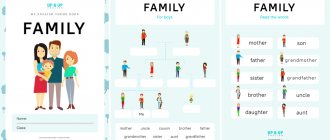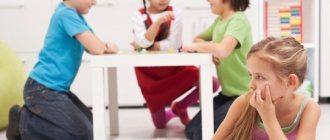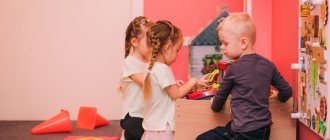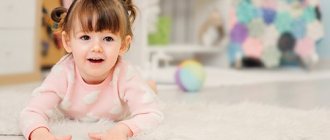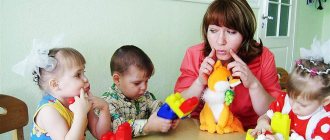The emphasis in modern education of preschool children is on developmental education. Math classes are no exception. The formation of elementary mathematical concepts develops personality, intelligence, logic and abstract thinking. It sharpens attention and memory, develops speech and promotes the most comfortable integration of the baby into the world around him. Fun math for children 3-4 years old will help develop qualities such as curiosity, goal achievement, and discipline. Introduces spatial and temporal logic.
What does mathematics teach 3-4 year old children?
Every educated parent wants to understand how well their child is developed. Are you missing any skills that are important in the modern world that you should focus on? To adequately assess children's knowledge and skills, you need to know what today's education system requires of them.
Mathematics for three-year-old children
Mathematics at 3 years old in kindergarten is not difficult. Children should:
- Master working with numbers within five. This is both an ordinal and a reverse count.
- Understand what this or that number consists of (for example, 5 is 4+1).
- When counting, use fingers, counting sticks, and other available objects.
- Correctly use the names of ordinal numbers, as well as cardinal numbers in the names of numbers.
- Recognize written numbers and be able to write them yourself.
- Name the number that comes before the given one, as well as after it.
- Use the terms “more”, “less”, “the same”. Clearly understand the difference between them.
- Master orientation in space (for example, show on a piece of notebook where the lines are higher and lower, which are on the left, right, between them, what is in the center, what is above, what is below).
For your information! Children must distinguish objects.
By size:
- Big bigger.
- Small - less.
- Short - shorter.
- Long - longer.
- Tall - higher.
- Low - lower.
- Wide - wider.
- Narrow - narrower.
Math classes
By geometric shape:
- square;
- circle;
- triangle;
- rectangle.
They must find these figures and be able to draw them, name the geometric shape of surrounding objects. Learn to identify their color. Distinguish between a circle and a ball, a square and a cube.
Counting and numbering numbers
The teacher’s task is to understand whether children understand the ultimate purpose of counting and why they are doing it.
Mathematics for children aged 3-4 years has its own characteristics. It is necessary to direct their attention to the study of a serious subject. For this purpose, all kinds of auxiliary materials and presentations are used.
Studying figures in preschool educational institutions
Fairy tales, toys, cubes, pictures (characters from fairy tales and cartoons printed on a color printer will be excellent handouts), lapbooks will also come in handy. They are easy enough to make yourself.
Children must master the names of numbers. But often they do not project this knowledge onto what concerns them. For example, a child knows ordinal counting perfectly, but cannot count his fingers. He simply doesn't connect the two.
Important! The teacher’s task is not only to give the concept of numbering and counting, but also to connect these things with the real world in the child’s mind.
Doing exercises with children in English
How we play math
We have been playing math games with our children since early childhood, from the age of 3. The first was the game “Kitten's Journey”.
My son picked up a toy kitten, we sat down in front of the globe, and the journey began. We imagined that a fast train was rushing a kitten from our city across the entire continent, and tried to imagine the pictures that the kitten sees. Along the way, the kitten had to draw a path through a maze, or collect precious stones in a cave, or help a little beaver build a house. Of course, our son helped the kitten complete the proposed tasks. Sometimes we “boarded” into a rocket and flew to the stars, exploring them, the planets and space itself. Sometimes we shrank down to microscopic size and traveled through the blood vessels of the human body, studying the composition of the blood and the location and properties of the body's organs. The son grew, the tasks became more complicated. His next favorite game was Lego Programming. We drew labyrinths through which, by issuing commands “forward”, “backwards”, “right”, “left” with four colors of Lego blocks, we had to guide a robot or car. At the same time, there were many games for classification and sorting of objects.
Then a math club was organized for children aged 4-6 years old - we spent two years together playing and learning new things. Then our daughters were born, after them new games appeared and the old ones were enriched. Finally, we collected what we had accumulated over ten years of study into a book. Each chapter begins with a story about how dad or mom play with their children - Kolya and Katya. You can discuss the games from the story with your child, you can play them, or you can complete the tasks suggested at the end of the chapter.
Here are some games from this book.
Four cars
An example of a visual game for sorting objects by color.
- Dad, I'm bored! Play with me! - Kolya called his father. - Fine. What are we going to play? - In Lego. - Amazing. Would you like me to show you something interesting? - Dad sat down opposite Kolya and poured out all the Lego between them. Then dad took four trucks from the shelf and suggested: “We have Lego parts in four colors.” Let's arrange them among the cars: the first one will carry red parts, the second one will carry blue parts, and the next two will carry yellow and green parts. We will take the parts to the other end of the room and there we will build four garages from them: red, blue, yellow and green.
Robot in the maze
This game is aimed at developing algorithmic thinking. This is how we learn to solve complex problems using a sequence of simple actions.
- Kolya, imagine that you are a robot. Stand here, on the arrow showing the entrance to the labyrinth. You should only walk when you hear the command, and take one step at a time in the direction indicated to you. Katya will manage you.
The guys were happy and agreed. Then dad put Kolya in front of the entrance to the maze, and Katya next to Kolya, and said that the robot only understood simple commands: forward, backward, right and left; and that at each command he takes a step in the indicated direction and freezes, waiting for the next command. And that he cannot enter squares on which there are obstacles.
Multi-colored candies (logic problem)
Mom: - I bought you three candies: green, red and yellow. For Katya - not green, for Kolya - not yellow, for dad - neither red nor green. Guess which candies I bought for whom.
Math exercises
Additional material will be required for math classes. The preschool educational institution recommends “Igrachka” by L. G. Peterson. This teaching aid is intended for use in mathematics lessons for 3-year-olds in kindergarten. These notebooks can be purchased online. It is also recommended to use the technique of E.V. Kolesnikova.
Educational cards
Math for a 3-year-old child begins with pictures. Five cards are made with the numbers 1, 2, 3, 4, 5.
You need to prepare pictures of the same color, but different objects. For example:
- Blue color – car, ball, flower, umbrella, etc. (all the same color).
- Red color – car, ball, pencil, umbrella, etc.
- Yellow color – car, ball, ball, spoon, etc.
- Green color – car, ball, flower, umbrella, etc.
- Black color – car, ball, pencil, umbrella, etc.
- White color – car, ball, flower, umbrella, hare, etc.
This will gather a working presenter to study the initial account. The objects in the pictures must be of different sizes.
Tasks:
- Find all red cards. Find and name each picture.
- Find all yellow cards. Find and name each picture.
- Find all blue cards. Find and name each picture.
- Find all green cards. Find and name each picture.
- Find all black cards. Find and name each picture.
- Find all white cards. Find and name each picture.
After the children have completed the task, you can move on to the next stage.
Further tasks become more difficult. You need to select all the cards where the car is drawn. All cards with a ball on them.
For your information! Having different colors is very confusing for children at first.
Comparison "More-less"
Mathematics for a 3-year-old child, which takes place in a preschool educational institution, includes the study of comparisons. The concepts of “more” and “less” are explained to children. A set of cards from previous lessons is used:
- Find all the cards with a ball on them. Then find all the cards where an umbrella is drawn. Compare the number of cards. Find which drawings there are more.
- Find all cards with a drawn flower. Then find all the cards with a drawn car. Find which pictures are smaller.
For clarity, you can put together a picture with a car and a flower. Which pictures will be left without a pair, those and more. The ones that ended earlier are smaller.
Studying the concept of “The same amount”
At the beginning of the lesson (if someone is celebrating their fourth birthday), the parents of the birthday boy brought cake and sweets. How to determine how much sweets each child needs without using numbers? Children express their suggestions.
The term “same” is introduced. The guys practice learning a new word. Problems with similar terms are solved:
- Also;
- equal quantity;
- the same.
Learning colors
Your child can easily remember the primary colors when you visually show him a few objects.
Red color
Show your child the picture and look carefully at what is shown on it. Speak out the object that is drawn on it and always the color of this object.
Any picture will enlarge if you click on it:
The picture shows a red ball.
The picture shows a red bow.
The picture shows a red tomato.
The picture shows a red car.
The picture shows a red umbrella.
Blue color
Look carefully at each picture with your child and repeat that the color is blue.
The picture shows a blue ball.
The picture shows a blue umbrella.
The picture shows a blue car.
The picture shows a blue bird.
Yellow
Look carefully at each picture with your child and repeat that the color is yellow.
The picture shows a yellow pepper.
The picture shows a yellow star.
The picture shows yellow bananas.
The picture shows a yellow car.
The picture shows a yellow sun.
Green color
Look carefully at each picture with your child and repeat that the color is green.
The picture shows a green cucumber.
The picture shows a green horse.
The picture shows a green ball.
The picture shows a green turtle.
The picture shows a green leaf.
White color
Look carefully at each picture with your child and repeat that it is white.
The picture shows a white bunny.
The picture shows a white horse.
The picture shows a white fox.
The picture shows a white dove.
Black color
Look carefully at each picture with your child and repeat that the color is black.
The picture shows a black bird.
The picture shows a black cat.
The picture shows a black horse.
The picture shows a black car.
After learning all the colors, look and do the following exercises. Your child can strengthen his new knowledge. After learning the colors, play visually with your child. Here the child will use auditory memory, visual memory, and attention.
About counting on fingers
At the first stage of learning to count on fingers, you need to firmly grasp all possible combinations. The child should not think about the answer within one hand.
Cognitive development of younger and older preschoolers
Attentiveness and memory develop, including tactile memory, because counting takes place in the head. You have to hold several data in memory at the same time. A quick solution depends on intelligence and speed of perception.
Child counts on fingers
Before learning to count on fingers, the child is already familiar with the concepts of “more,” “less,” and “also.” Can count objects in order within five.
Further:
- You need to start with 1+1=2. Children put two fingers together and get 2.
- Then add another finger = 3.
- Add one more to three and get the fourth result (four).
- Add one more finger to four and get five.
Now you can master subtraction:
- Subtract one finger from five and it becomes four.
- Subtract one finger from four and it becomes three.
- If you take away one finger from three, there will be two left.
- Subtract one finger from two and one remains.
The lesson should not exceed 20 minutes. Children get tired quickly. You can diversify the lesson by changing activities - warming up, singing something, solving riddles, and so on.
Important! You can't force it. It is always easier to “lure” someone somewhere than to force them. Elements of play, competition and reward will do more and better than anything else.
